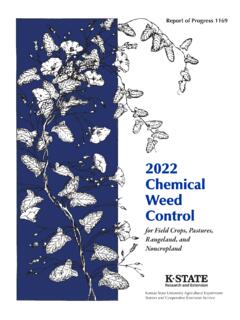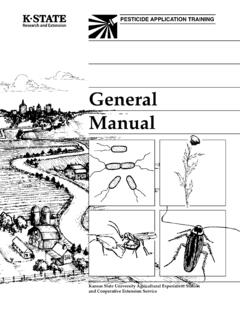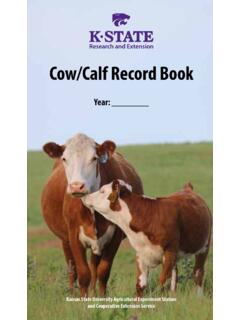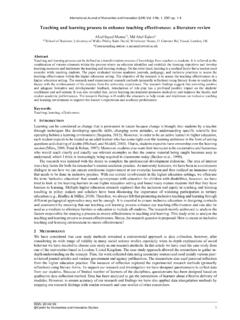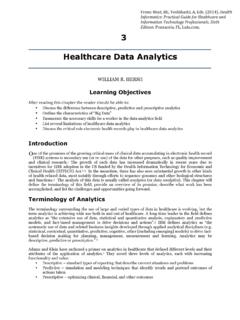Transcription of Wheat Growth and Development - KSRE Bookstore
1 Wheat Growth and Development Terminal spikelet Double ridge 1 2 3 4 5 6 7 8 9 10 Feekes Scale of Wheat Development Leaf and Tiller Development Stem Elongation Heading and Flowering Grain Filling Ripening Germination. Seeds absorb water Feekes 5 Feekes and oxygen. The radicle, seminal roots, Leaf sheaths strongly erect. The Heading. The first heads escape and the coleoptile (leaflike structure pseudo-stem is strongly erect and leaf through a split in the flag leaf sheath enclosing the first true leaf ) emerge sheaths are elongated. The developing at Feekes All heads are out of the from the seed. Temperatures between head reaches the terminal spikelet sheath at Feekes It usually takes 54 and 77 degrees Fahrenheit are stage and is pushed up into the 3 to 5 days for the head to fully extend optimal for germination.
2 Pseudo-stem. The potential number above the flag leaf. Temperatures Coleoptile Management. Use certified seed Developing of spikelets per head is determined at below 30 degrees Fahrenheit may or ensure good seed cleaning and Head Feekes 5. The first hollow stem stage damage the developing head. Crop Head Emergence and Flowering sizing. Fungicide and insecticide seed occurs when there is approximately water demand can exceed inch per Seminal treatments can help manage early- inch of hollow stem below the day during heading through the soft Roots season diseases and insect pests. Soil inch developing head. Crop water use is dough stage. test and ensure 30 to 40 pounds of Hollow about inch per day. Management. Scout for insects, Radicle nitrogen per acre are available for Stem Management. Ideal time for second weeds, and diseases.
3 A fungicide fall Growth . In dual-purpose systems, nitrogen application if split applying in application may be considered to ensure 40 pounds of nitrogen per acre the spring. Cattle should be removed protect heads from scab. Check are available per 1,000 pounds per acre from dual-purpose Wheat before first fungicide label for pre harvest interval of forage goal. hollow stem. restrictions. Feekes 1 Feekes 6 Feekes Emergence. Emerging from the soil, First node of stem visible (jointing). Flowering (anthesis). Flowering the coleoptile stops growing when it The first node of the stem becomes begins shortly after the head has senses light. The first true leaf emerges visible as a result of internode fully emerged and lasts 3 to 5 days, through the tip of the coleoptile. Three elongation. Nodes are stacked and starting slightly above the middle leaves fully develop before tillering move up as the internodes elongate portion of the head.
4 Feekes initiation. The seminal rooting system Developing much like a telescope. Sensitivity to occurs when flowering is complete at Head the top of the head and Feekes expands. The crown forms between the Node low temperatures increases as the seed and soil surface. developing head is pushed up by the occurs when flowering is complete Crown expanding stem. Crop water demand at the base. The number of flowers Crown/Nodal Management. Scout for proper Internodes increases to about inch per day. pollinated determines the number of Roots emergence with a targeted stand of 15 Anthers Sub-Crown Approximately 25 percent of the total kernels per head. At this stage, Wheat is Internode to 25 plants per square foot, depending dry matter is accumulated by this extremely susceptible to freeze injury Seed on annual precipitation.
5 Monitor fields Stigma stage. at temperatures below 32 degrees for fall armyworm and other early- Fahrenheit. Approximately 75 percent Seminal Roots season pests. Management. Consider a first of the total dry matter is accumulated fungicide application under significant by this stage. disease pressure. Do not apply Feekes 2 dicamba or 2,4-D after Wheat reaches Management. Scout for insects, Tillering initiation. Tillers are initially jointing, and avoid equipment with weeds, and diseases. Make note of encased in a protective structure called wide tires. weed escapes for future years. Attend the prophyll. If there are three leaves variety tours and identify new varieties visible, a tiller will be at the base of the for your operation. Axillary first leaf. Fall-formed tillers contribute Developing Feekes 7. Leaf and Tiller Development Tiller more to grain yield than spring-formed Head Second node of stem visible.
6 Tillers. The crown root system starts to As the second node of the stem develop. Node Internodes becomes visible, the next-to-last leaf Feekes is just visible. Demand for water and Watery ripe. Establishment of kernel Management. In dual-purpose nutrients increases. Temperatures length about 10 days after flowering. systems, start grazing only after Prophyll lower than 24 degrees Fahrenheit can Rapid increase in grain size, but little establishment of crown roots, which Node damage the developing head. dry matter accumulation. A clear fluid anchor plants in the soil. Management. Plant Growth regulators can be squeezed from the developing kernel. Feekes 3 may be applied at this Growth stage. Watery ripe Continued tillering. Primary tillers Scout for insects, weeds, and diseases. Stem Elongation develop in the axils of the first four Feekes or more true leaves of the main Milky ripe (milk stage).
7 Increase in stem. Secondary tillers may develop Feekes 8 solids content in the endosperm from from the base of primary tillers. Tiller Last leaf just visible. The flag leaf photosynthates. This stage occurs 15 to Development is prioritized based starts to emerge from the whorl 18 days after flowering. A milklike fluid on their sequential formation. The above the third or fourth node. Strong can be squeezed out of the kernels Development of the crown root partitioning of photosynthates to the Flag Leaf when crushed between fingers. system increases extensively. From 5 developing head. Crop water demand Grain Filling to 15 percent of the total dry matter is increases to about inch per day. Approximately 45 percent of the total accumulated by this stage, depending dry matter is accumulated by this Feekes on sowing date, seeding rate, fertility, Mealy ripe (soft dough).
8 During fall temperatures, and moisture stage. Milk stage the dough stage, the kernel rapidly availability. Management. To maintain optimal accumulates starch and nutrients Management. Scout for insect pests leaf area, scout for diseases and pests. and most of its dry weight. Material and weeds. Fall herbicide applications squeezed out of the kernel has a generally provide better control, reducing weed competition. Feekes 9 doughy consistency. Green color begins to fade and kernels are soft but Ligule of flag leaf visible. The flag leaf is completely emerged from the dry. Maximum dry matter accumulation Winter dormancy whorl. Flag leaf and the next-to-last (100 percent) by the end of this stage. Vernalization. Gradually lowering Flag Leaf leaf (penultimate leaf ) combined temperatures and shortening day account for 70 to 90 percent of the Feekes length induce winter hardiness photosynthates used for grain fill and Soft dough Kernel hard (hard dough).
9 Kernel in winter Wheat . Vernalization must be protected for the plant to moisture decreases from 40 to 30. requirements range from three to develop to its full potential. percent during ripening. Kernels eight weeks of temperatures below 50 achieve maximum dry weight and Penultimate Management. Scout for insects degrees Fahrenheit. Leaf are physiologically mature. Kernels and diseases. Consider a fungicide Management. Manage stocking application to protect the flag leaf if are hard and difficult to divide with density in dual-purpose Wheat systems foliar diseases are present on the lower thumbnail. and try to maintain 60 percent canopy canopy. Nitrogen application can coverage. increase grain protein levels. Management. Monitor the crop for Feekes 3 head scab and adjust yield predictions Completion of tillering.
10 Once Feekes 10 and marketing plans if present. Scout requirements are met, the growing Boot. The head is inside the leaf for Wheat head armyworm. Severe heat point differentiates and the embryonic sheath giving it a swollen appearance. Hard dough or water stresses can reduce grain test head reaches the double ridge The flag leaf sheath and peduncle weight. stage. Depending on the season and Boot elongate and the developing head is planting date, some tillering occurs pushed through the flag leaf sheath. in the spring. Genetic potential and Temperatures below 28 degrees Feekes environmental conditions determine Fahrenheit may cause damage to the Kernel ripe. Kernel moisture decreases the number of tillers on a plant. developing head. from 30 to 15 percent during ripening, Ripening Tillers with three or more leaves are Management.
